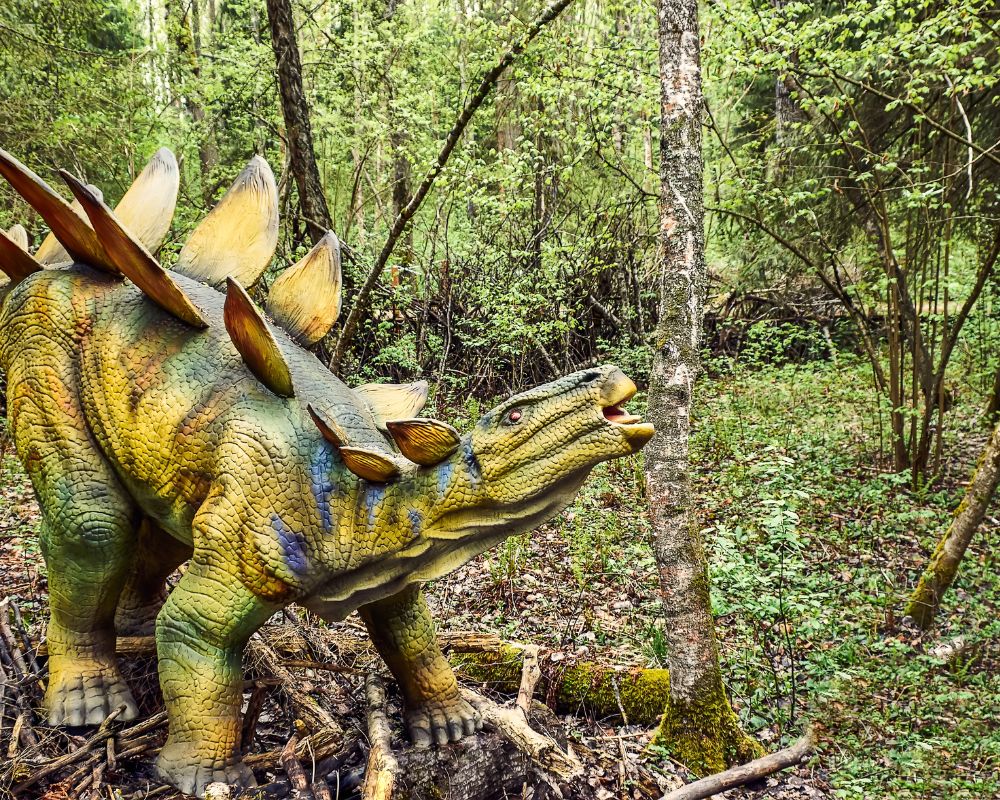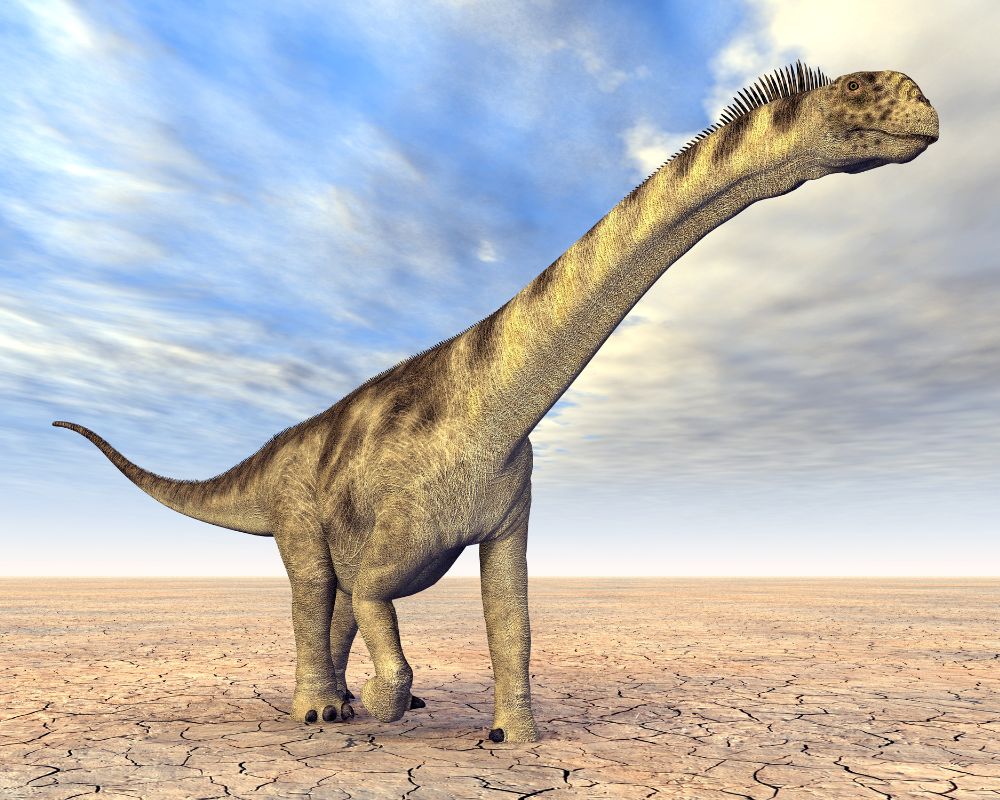Stegosauruses were a part of the group of armored dinos that included Ankylosaurs and Kentrosaurus. The Stegosauridae family had spiked tails they used for protection and bony plates along their spine. Stegosaurus plates were full of blood vessels for cooling body temperature!
Table of Contents
Some Quick Facts About the Stegosaurus

| Name | Stegosaurus (meaning “Roof Lizard”) |
| Type of dinosaur | Armored dinosauria from the Ornithischian order |
| Territory | Western US |
| Size | Large dino that was 22-29 feet long, 9-13 feet tall |
| Color | Reddish brown to olive green for camouflage |
| Interesting Characteristics | Stegosaurus had leaf-shaped teeth and tail spikes |
| Diet | Herbivore that fed mostly on soft cycads |
| Major Threats | Allosaurus and climate change that led to the extinction of prehistoric cycad plants |
What was the Stegosaurus like?
Based on some reconstructions, the Stegosaurus was brownish and large, about 22-29 feet long, and 9-13 feet tall. It walked on all four legs and was among the easily identifiable dinos.
The Stegosaurus belonged to the group of armored dinos, together with the Ankylosaurs and the Kentrosaurus. Its spiked tails and bony plates served to protect and cool off the body temperature.
Why is Stegosaurus called the Dumbest Dinosaur?

Stegosaurus dinos had really small brains. It was the size of a walnut! They also had very small heads. Paleontologists used to believe that Stegosaurs and other small-brain dinos had a second brain in their tails.
Why are the Tail Spikes called Thagomizers?
Stegosaurus’ tail spikes are called thagomizers, but the name didn’t come from paleontologists. In 1982, comic artist Gary Larson drew an image of cavemen teaching a dinos class. In the comic, the teacher points to a Stegosaurus’s spiked tail.
Since paleontology didn’t have a name for the tail spikes, the Far Side artist made one up. He named the tail spikes “thagomizers” after the made-up Thag Simmons. Paleontologists liked the name and started using thagomizer officially!
What Dinos Lived with Stegosaurus?





Stegosaurus lived in North America around 155-145 million years ago. They lived with many other famous dinos like:
- Allosaurus
- Apatosaurus
- Brachiosaurus
- Camarasaurus
- Camptosaurus
- Ceratosaurus
- Diplodocus
Even though Stegosaurus didn’t live in traditional herds, many herbivores stuck together. Large Sauropods like Brachiosaurus and Diplodocus were found in the same areas as Stegosaurus fossils. During the Jurassic Period through the Cretaceous period, states like Colorado, Montana, Utah, and Wyoming were filled with dinos roaming the land!
After the Stegosaurus went extinct, other well-known dinos lived in the USA. These include Ankylosaurs, T-rex, and Triceratops. There was even a huge Pterosaur called Quetzalcoatlus.
What was Stegosaurus’s Main Defense against Predators?
Stegosaurus’s spiked tail was its main defense against predators. It could swing its long tail and hit predators like Allosaurus when they were behind or beside Stegosaurus. This helped the slower Stegosaurus escape the Allosaurus, but it didn’t always work.
Still, the Allosaurus wasn’t the reason Stegosaurus went extinct. As the climate changed between the Late Jurassic Period and the Early Cretaceous, the cycads Stegosaurus ate went extinct. Because of their weak jaw, other plants were too hard to chew, and Stegosaurus eventually ran out of food.
How Many Types of Stegosaurs Are There?
Stegosauruses belonged to a suborder of armored dinos called Stegosauria. This group includes the Stegosaurus species plus over a dozen Stegosaurus look-a-likes from all over the world.
The Stegosaurus species are:
- Stegosaurus stenops
- Stegosaurus ungulatus
- Stegosaurus sulcatus
- Stegosaurus armatus
While Othniel C. Marsh found several Stegosaurus fossils in the late 1880s, those specimens were mostly incomplete. In fact, of the over 80 Stegosaurus fossils found in the Morrison Formation during that time, none of them were complete. Because of this, it took several years for the picture of Stegosaurus to take shape.
The complete Stegosaurus skeleton didn’t resurface until over 100 years later, in 2014! This Stegosaurus skeleton is on display at the Natural History Museum in London. Luckily paleontologists were able to piece together everything they knew about Stegosaurus so we could enjoy this amazing dino and all its creature features!
What are 3 interesting facts about Stegosaurus?
- Paleontologists found that the Stegosaurus had one of the weakest mouths among herbivores. This is probably why it loved cycads. Cycads were small palm-like trees with cones and ferny leaves.
- The Stegosaurus was slow, moving about 9-11 mph. Some scientists even think the Stegosaurus was slower at 3-5 mph. That made them easy to catch for the Allosaurus, who could run 19-34 mph!
- The Stegosaurs had much longer hind legs than many quadrupeds. Even though they still walked on all fours, scientists also believe they could stand on their hind legs to reach higher leaves. These longer hind legs are a big part of the reason they were so slow.
